Input interpretation

tellurium (chemical element) | bismuth (chemical element) | tin (chemical element)
Periodic table location
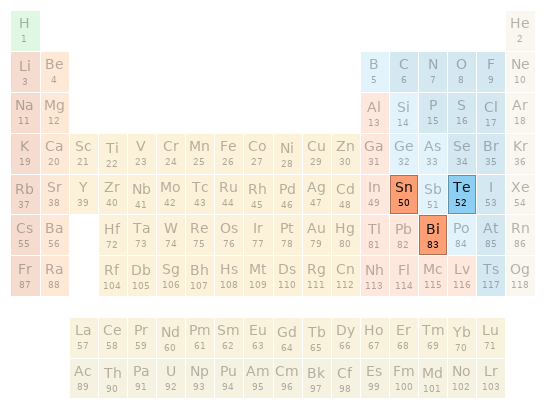
Periodic table location
Images
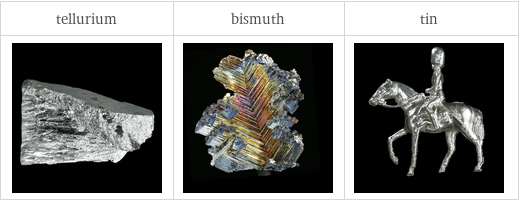
Images
Basic elemental properties
![| tellurium | bismuth | tin atomic symbol | Te | Bi | Sn atomic number | 52 | 83 | 50 short electronic configuration | [Kr]5s^24d^105p^4 | [Xe]6s^24f^145d^106p^3 | [Kr]5s^24d^105p^2 Aufbau diagram | 5p 4d 5s | 6p 5d 4f 6s | 5p 4d 5s block | p | p | p group | 16 | 15 | 14 period | 5 | 6 | 5 atomic mass | 127.6 u | 208.9804 u | 118.71 u half-life | (stable) | 1.9×10^19 yr | (stable)](../image_source/64212c854c464d0495b7747dd7088af4.png)
| tellurium | bismuth | tin atomic symbol | Te | Bi | Sn atomic number | 52 | 83 | 50 short electronic configuration | [Kr]5s^24d^105p^4 | [Xe]6s^24f^145d^106p^3 | [Kr]5s^24d^105p^2 Aufbau diagram | 5p 4d 5s | 6p 5d 4f 6s | 5p 4d 5s block | p | p | p group | 16 | 15 | 14 period | 5 | 6 | 5 atomic mass | 127.6 u | 208.9804 u | 118.71 u half-life | (stable) | 1.9×10^19 yr | (stable)
Thermodynamic properties

| tellurium | bismuth | tin phase at STP | solid | solid | solid melting point | 449.51 °C | 271.3 °C | 231.93 °C boiling point | 988 °C | 1564 °C | 2602 °C molar heat of fusion | 17.5 kJ/mol | 10.9 kJ/mol | 7 kJ/mol molar heat of vaporization | 48 kJ/mol | 160 kJ/mol | 290 kJ/mol specific heat at STP | 201 J/(kg K) | 122 J/(kg K) | 217 J/(kg K) (properties at standard conditions)
Material properties

| tellurium | bismuth | tin density | 6.24 g/cm^3 | 9.78 g/cm^3 | 7.31 g/cm^3 liquid density | 5.7 g/cm^3 | 10.05 g/cm^3 | 6.99 g/cm^3 molar volume | 20.45 cm^3/mol | 21.37 cm^3/mol | 16.24 cm^3/mol Mohs hardness | 2.25 (between gypsum and calcite) | 2.25 (between gypsum and calcite) | 1.5 (between talc and gypsum) Brinell hardness | 180 MPa | 94.2 MPa | 51 MPa bulk modulus | 65 GPa | 31 GPa | 58 GPa shear modulus | 16 GPa | 12 GPa | 18 GPa Young's modulus | 43 GPa | 32 GPa | 50 GPa Poisson ratio | | 0.33 | 0.36 ultimate tensile strength | 11 MPa | | 220 MPa refractive index | 1.000991 | | (unknown) sound speed | 2610 m/s | 1790 m/s | 2500 m/s thermal expansion | | 1.34×10^-5 K^(-1) | 2.2×10^-5 K^(-1) thermal conductivity | 3 W/(m K) | 8 W/(m K) | 67 W/(m K) (properties at standard conditions)
Electromagnetic properties
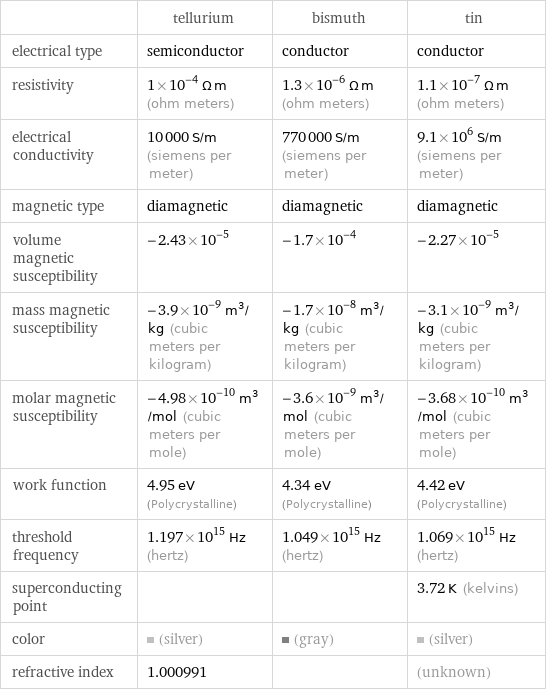
| tellurium | bismuth | tin electrical type | semiconductor | conductor | conductor resistivity | 1×10^-4 Ω m (ohm meters) | 1.3×10^-6 Ω m (ohm meters) | 1.1×10^-7 Ω m (ohm meters) electrical conductivity | 10000 S/m (siemens per meter) | 770000 S/m (siemens per meter) | 9.1×10^6 S/m (siemens per meter) magnetic type | diamagnetic | diamagnetic | diamagnetic volume magnetic susceptibility | -2.43×10^-5 | -1.7×10^-4 | -2.27×10^-5 mass magnetic susceptibility | -3.9×10^-9 m^3/kg (cubic meters per kilogram) | -1.7×10^-8 m^3/kg (cubic meters per kilogram) | -3.1×10^-9 m^3/kg (cubic meters per kilogram) molar magnetic susceptibility | -4.98×10^-10 m^3/mol (cubic meters per mole) | -3.6×10^-9 m^3/mol (cubic meters per mole) | -3.68×10^-10 m^3/mol (cubic meters per mole) work function | 4.95 eV (Polycrystalline) | 4.34 eV (Polycrystalline) | 4.42 eV (Polycrystalline) threshold frequency | 1.197×10^15 Hz (hertz) | 1.049×10^15 Hz (hertz) | 1.069×10^15 Hz (hertz) superconducting point | | | 3.72 K (kelvins) color | (silver) | (gray) | (silver) refractive index | 1.000991 | | (unknown)
Reactivity
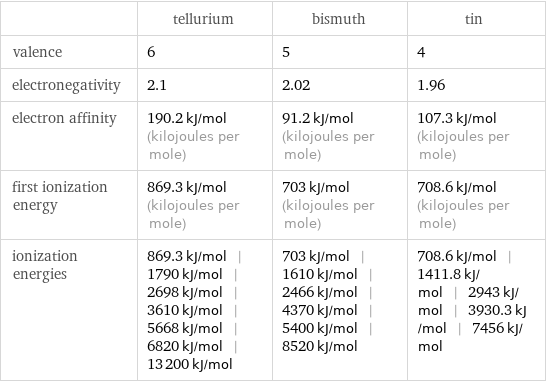
| tellurium | bismuth | tin valence | 6 | 5 | 4 electronegativity | 2.1 | 2.02 | 1.96 electron affinity | 190.2 kJ/mol (kilojoules per mole) | 91.2 kJ/mol (kilojoules per mole) | 107.3 kJ/mol (kilojoules per mole) first ionization energy | 869.3 kJ/mol (kilojoules per mole) | 703 kJ/mol (kilojoules per mole) | 708.6 kJ/mol (kilojoules per mole) ionization energies | 869.3 kJ/mol | 1790 kJ/mol | 2698 kJ/mol | 3610 kJ/mol | 5668 kJ/mol | 6820 kJ/mol | 13200 kJ/mol | 703 kJ/mol | 1610 kJ/mol | 2466 kJ/mol | 4370 kJ/mol | 5400 kJ/mol | 8520 kJ/mol | 708.6 kJ/mol | 1411.8 kJ/mol | 2943 kJ/mol | 3930.3 kJ/mol | 7456 kJ/mol
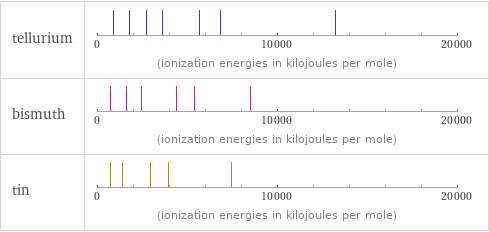
Reactivity
Atomic properties
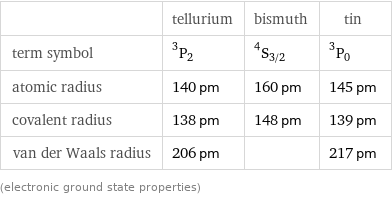
| tellurium | bismuth | tin term symbol | ^3P_2 | ^4S_(3/2) | ^3P_0 atomic radius | 140 pm | 160 pm | 145 pm covalent radius | 138 pm | 148 pm | 139 pm van der Waals radius | 206 pm | | 217 pm (electronic ground state properties)
Abundances
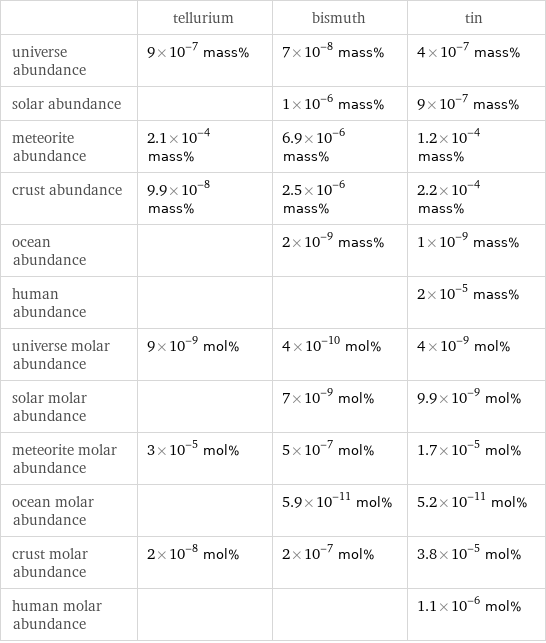
| tellurium | bismuth | tin universe abundance | 9×10^-7 mass% | 7×10^-8 mass% | 4×10^-7 mass% solar abundance | | 1×10^-6 mass% | 9×10^-7 mass% meteorite abundance | 2.1×10^-4 mass% | 6.9×10^-6 mass% | 1.2×10^-4 mass% crust abundance | 9.9×10^-8 mass% | 2.5×10^-6 mass% | 2.2×10^-4 mass% ocean abundance | | 2×10^-9 mass% | 1×10^-9 mass% human abundance | | | 2×10^-5 mass% universe molar abundance | 9×10^-9 mol% | 4×10^-10 mol% | 4×10^-9 mol% solar molar abundance | | 7×10^-9 mol% | 9.9×10^-9 mol% meteorite molar abundance | 3×10^-5 mol% | 5×10^-7 mol% | 1.7×10^-5 mol% ocean molar abundance | | 5.9×10^-11 mol% | 5.2×10^-11 mol% crust molar abundance | 2×10^-8 mol% | 2×10^-7 mol% | 3.8×10^-5 mol% human molar abundance | | | 1.1×10^-6 mol%